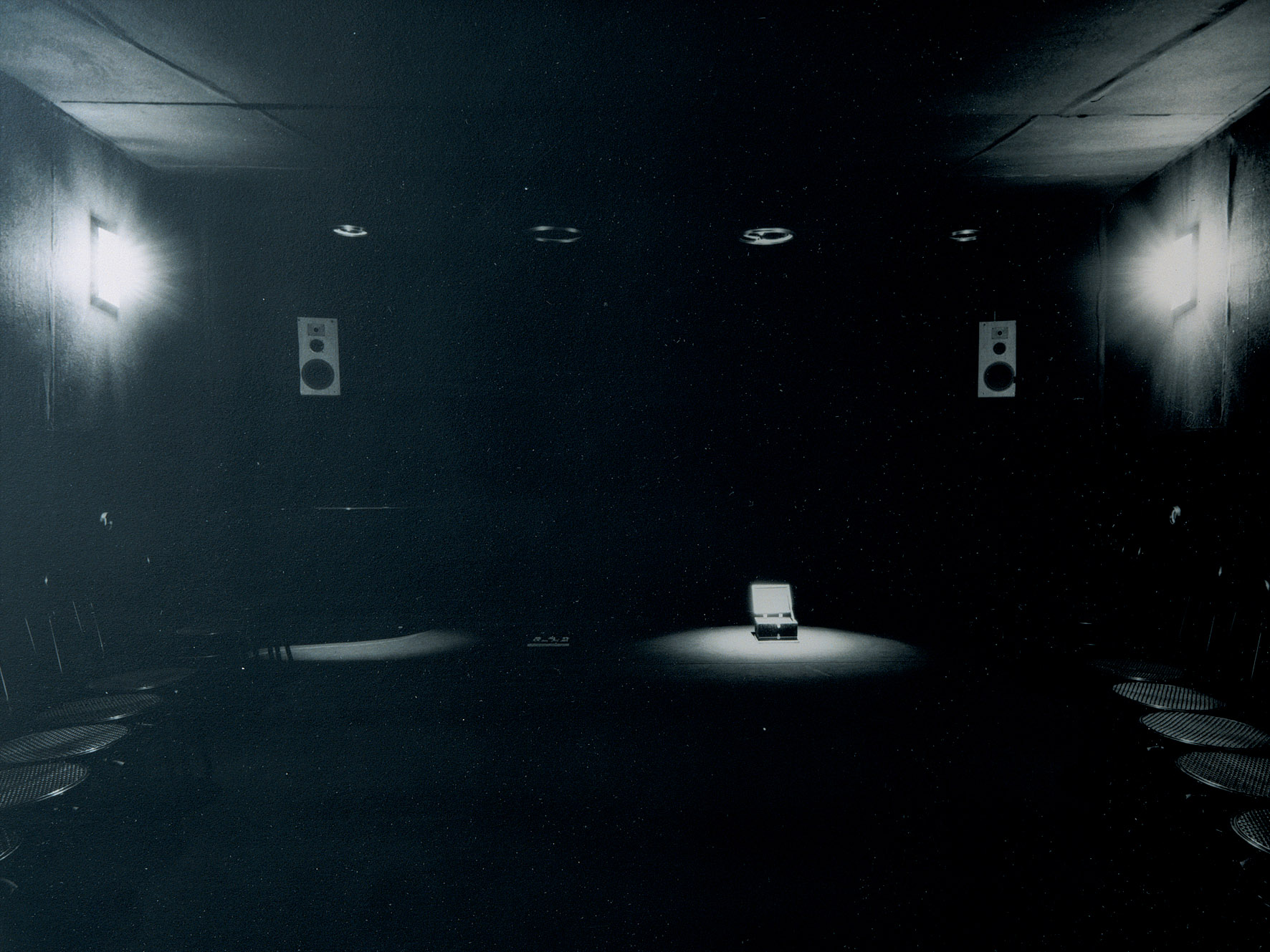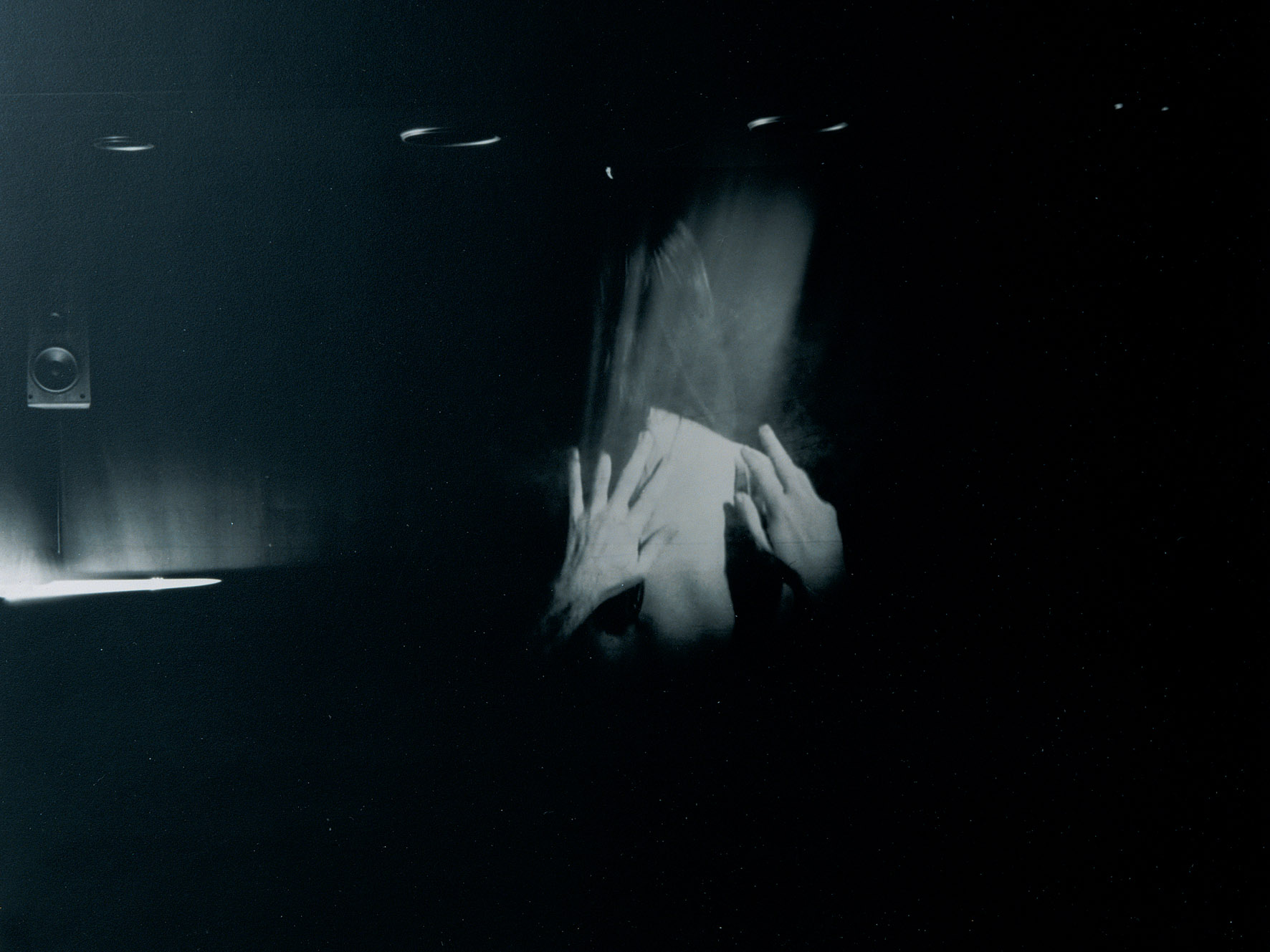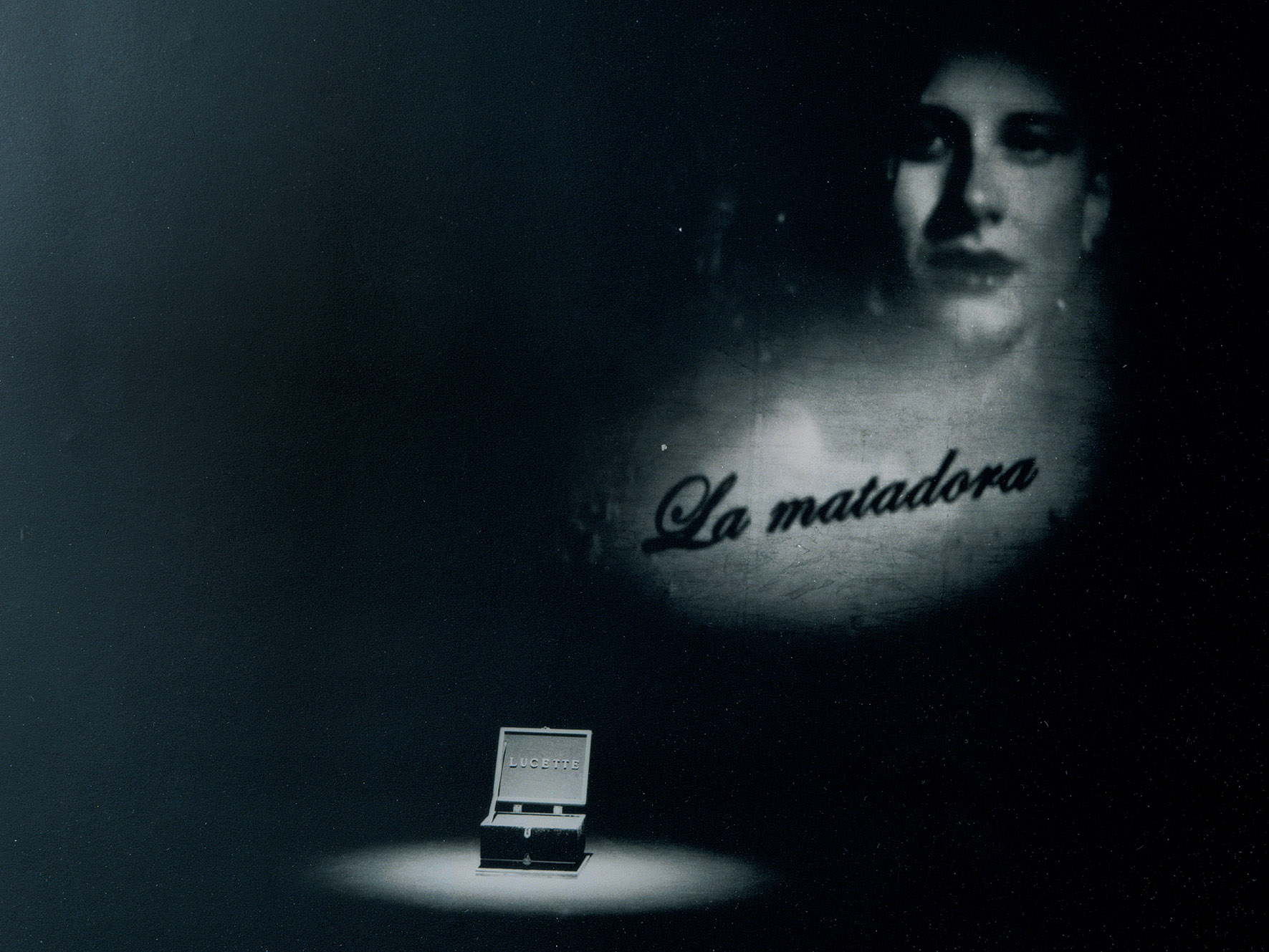Vaniada
for Ada, Van, video, piano and sound devices
- Concept: Luigi de Angelis, Chiara Lagani
- Direction, lighting design and sound devices: Luigi de Angelis
- Dramaturgy and costumes: Chiara Lagani
- Set: Luigi de Angelis, Antonio Rinaldi
- Video images: Zapruder Filmmakersgroup
- Music: Morton Feldman and various artists
- Piano: Matteo Ramon Arevalos
- With: Luigi de Angelis, Marco Cavalcoli, Chiara Lagani and with Sara Masotti
- Scene movements: Antonio Rinaldi
- Scenery and technical realization: Giovanni Cavalcoli with Marco Cavalcoli, Lucia Maestri, Marco Molduzzi, Antonio Rinaldi
- Synaesthesias: Maria Sebregondi
- Tailoring: Laura Graziani Alta Moda
- Catering: Marco Molduzzi with Anna Maria Bollettieri, Maria Antonietta d’Errico, Loretta Masotti
- Promotion: Sergio Carioli, Marco Molduzzi
- Press office: Marco Molduzzi
- Logistics: Sergio Carioli
Administration: Antonietta Sciancalepore, Marco Cavalcoli - Production: Fanny & Alexander and Ravenna Festival, with the cooperation of Festival delle Colline Torinesi, with the contribution of Fondazione Cassa di Risparmio di Ravenna
- With thanks to: Gastone Bardetta, Stefano Bartezzaghi, Augusta Biaggi, Erik Borgman, Margherita Crepax, Compagnia Donati-Olesen, Andrea Catalano, Electa-Antichità di Maria Carla Costa, Enrico Fedrigoli, Monica Francia, Marina Grishakova, Gerardo Lamattina, Franco Masotti, Venerina and Adelmo Masotti, Paula Noah de Angelis, P-Bart, Daniele Perini, Elisabetta Rivalta, Symrise GmbH & Co. KG, Teatrino Clandestino
Year : 2005
The excerpts from Vladimir Nabokov’s works, translated in Italian by Margherita Crepax, are used in accordance with The Vladimir Nabokov Estate
WHY IS IT SO HARD – HARD IN SUCH A DEGRADING WAY – TO BRING THE NOTION OF TIME INTO MENTAL FOCUS?
IS THERE ANY MENTAL URANIUM WHOSE DREAM-DELTA DECAY CAN BE USED TO MEASURE THE AGE OF A MEMORY?
WHAT WAS IT THAT GRABBED MY ARM AND COMFORTED ME WHEN I LOST A THOUGHT, A SHORT WHILE AGO?
MAY THE DEVASTATION AND OUTRAGE OF AGE REPROVED BY POETS TELL ANYTHING ABOUT THE REAL ESSENCE OF TIME?
HOW CAN I EXTRACT IT FROM ITS SOFT NICHE?
VAN I ADA:
(Van and Ada)
Here are two rocky ruin-crowned hills. We have kept them in mind for three years with decalcomaniac, romantic lividness. We have invested a fortune in them, in terms of cash and emotions. Ardis I, Ardis II, Villa Venus, Aqua Marina, Lucinda’s Museum, oh, Speak, Memory, Speak!!! Memory will surely appreciate our own personal contributions. But now it’s time to celebrate the long awaited nuptials: do you Ada Veen take as your lawfully wedded husband Van Veen, and do you Van take Ada, till death do you part?
VAN I ADA!
What now? Whatever can our lovers see now? Nothing. A field of untidy ruins to which they will make their own special contribution. Yes, we are in the middle of Eocene and the actors are fossils. They live in the desert. Their heart beats to the rhythm of the craziest natural catastrophe, a technological and political-criminal one. They stand in the middle of a colossal relict: their work, so distant, has already acquired the symbolical status of ruin. Their future can produce no more ruins. It doesn’t have time.
TOUR
June 9, 2007 | Gualdo Cattaneo (PG), ENEL Power Plant, Ponte di Ferro, Tra Cielo e Terra Festival 2007
June 22/23/24, 2007 | Modena, Teatro delle Passioni, ERT
June 22/23, 2006 | Turin, Festival delle Colline Torinesi, Cavallerizza Reale
June 6, 2006 | Castrovillari (CS), Primavera dei Teatri VII Edition, Circolo Cittadino
April 3-14, 2006 | Ravenna, NOBODADDY, Ardis Hall
March 25, 2006 | Botticino (BS), Festival K5, Centro Lucia, Teatro Inverso
March 18/19, 2006 | Castel Maggiore (Bologna), Sguardi, Teatro Biagi D’Antona
February 24–28 + March 1–5, 2006 | Naples, Galleria Toledo
November 9–13, 2005 | Milan, Teatro i
October 21/22, 2005 | Scandicci (FI), No Answers, Only Questions – Italian/Beckettian Theatres – Other Scenes 05 – Theatre and Dance Flashes, Compagnia Teatrale Krypton, ETI – Ente Teatrale Italiano, Teatro Studio in collaboration with ARCUS
September 20/21, 2005 | Rome, Le Vie dei Festival 2005, Ass. Cult. Cadmo, Teatro Sala Uno
July 7-10, 2005 | Rimini, International Theatre Festival Santarcangelo dei Teatri, Teatro Novelli
June 23/24/25, 2005 | Ravenna, Ravenna Festival, Ardis Hall, National Premiere
June 14/15, 2005 | Turin, Festival delle Colline Torinesi, Cavallerizza Reale, National Preview
INSIGHTS
LEAVING ADA
Vaniada is envisioned as an exit. At the end of their story, Ada and Van, now over a century old and almost fused into a single archetypal being, face the great dilemma of ending: living within a work means knowing when to relinquish life as the work reaches its conclusion.
Vaniada addresses the end of the work in relation to Time and Memory. This central theme of the novel has only now been fully explored, a challenging subject that defies representation. An artwork always contains a discourse on Memory. But what happens when this Memory becomes an echo, a pure loss? What if the trace we’ve pursued (as puzzle solvers and detectives of the narrative) vaguely imprints an almost indecipherable mark upon our bodies? If Memory becomes an undefinable sign left—or about to be left—on us by the work? The work then seems like a mirror, reflecting us only in fragments. Ada and Van may no longer be viewed or recognized beyond our fragile appearances.
A linguistic mechanism, perhaps the most captivating of word games—the charade—enabled us to tackle this theme. The theme of Memory and its ambiguous reflections found its ambiguous core in the linguistic structure of the charade, or more precisely, the “double phrase.” What is a charade? “To create a charade, you take a word and split it into two parts, carefully choosing the point where an imaginary knife should cut. A charade can be seen as a word splitting into two others or as two words merging into one” (Lessons in Puzzles, S. Bartezzaghi). Example: the charade = Lasciar Ada (Leaving Ada). “Is it really the same thing?” Bartezzaghi asks. Not quite: “The author starts with the whole word and divides it, hoping to find two meaningful words. The solver starts with the parts, hoping to combine them into a meaningful whole” (emphasis mine). Once again, the battle for meaning hinges on the double challenge of symbol reconstruction, requiring the intense and collaborative interplay between observer and observed.
The monstrous word “Vaniada” now looms as a deeper, more impenetrable enigma. Where will we place the invisible knife that separates us from this work? Along the dark I that divides the two beloved names? Perhaps along that ultraslim I (meaning “and” in Russian)—a sharp cut, both division and conjunction in the word-title of the final performance. A conclusion that, to truly end, must admit that true closure may never be possible.
PRESS REVIEW
Enrico Fiore, Love, Incest, and the Jolts of Memory
Gianni Manzella, Claustrophobic Enigmas from Nabokov
Franco Cordelli, Fanny & Alexander: Nabokov Fans
Franco Quadri, Fanny & Alexander: Ambiguity as a Game
Alessandro Fogli, Vaniada: Nabokov’s Final Chapter for Fanny & Alexander
Love, Incest, and the Jolts of Memory
Enrico Fiore, Il Mattino, March 5, 2006
Rarely has a title held such deep significance—structurally, beyond just content—as “Vaniada,” presented by the Fanny & Alexander company at Galleria Toledo. This is the final chapter in their exploration of Nabokov’s novel Ada or Ardor: A Family Chronicle, a project awarded the 2005 Ubu Prize. The title “Vaniada” references a pivotal moment in the novel when Lucette, Ada’s younger sister, rearranges the names Van and Ada to form the word “divano” (sofa), where Van and Ada’s incestuous love first ignited.
By choosing “Vaniada” as their title, Luigi de Angelis and Chiara Lagani emphasize Nabokov’s crucial theme: the interplay between letters and reality. For Nabokov, writing captures both the grace and despair of trying to freeze life in form. Hence, Nabokov’s frequent use of anagrams, from “nicest/incest” to “Van’s Book”—a subtle nod to the author himself.
Fanny & Alexander transform this theme into a continuous and poignant fusion of technique and poetry. As Van and Ada approach the end of their lives, the focus shifts from anagrams (rearranging letters) to charades (splitting words). In the confined, dark space where the audience sits, profound shifts in meaning open minds and senses to vast external realms: feelings, memory jolts, and Proustian “heart intermittences.”
A striking example: while a charade reading “persona recondita” (hidden person) plays on one wall, another screen shows hands—Van’s—playing a piano on Ada’s bare back. The talented cast, including de Angelis and Lagani, deliver a powerful performance, culminating in a hand offering a fragrant rose through a circular wall opening. Life, as the play suggests, offers fleeting moments of joy amid inevitable losses.
Claustrophobic Enigmas from Nabokov
Gianni Manzella, Il Manifesto, July 10, 2005
The final charade reveals its meaning: “lasciar Ada” (leave Ada). Fanny & Alexander’s journey through Ada or Ardor nears its end. Van and Ada, now centenarians, are symbolically united by the Russian conjunction “i” (and). In Vaniada, showcased at Santarcangelo after its Ravenna Festival debut, time and memory converge. Memorial plaques inscribed “Brother” and “Sister” symbolize their elusive, incestuous love.
Unlike the earlier phases of this project, this performance confines the audience in a claustrophobic space—a black funnel with walls pressing toward a circular vent. Projections by Zapruder evoke a bygone era: Ada’s bare back, glimpsed through dim, fragmented visuals, mirrors the play’s enigmatic theme. A maze of sounds—whispered voices, piano notes—fills the darkness, engaging all senses with scents like roses or cigar smoke.
Fanny & Alexander capture their “time regained” in a poignant finale to their enigmatic Nabokov journey.
Fanny & Alexander: Nabokov Fans
Franco Cordelli, Il Corriere della Sera, July 2, 2005
After exploring Ravenna’s historic characters, Fanny & Alexander turn to Nabokov’s vast novel, Ada or Ardor. Founded in 1992, this group, led by Luigi de Angelis and Chiara Lagani, embodies the passion of true fans. They have immersed themselves not merely in Nabokov but in Ada’s intricate world, embodying themes of memory, language, and love’s dissolution.
Their performance, Vaniada—an amalgamation of Van and Ada—delivers a powerful allegory. In their dark, industrial venue, spectators confront the inevitability of separation. The play juxtaposes rich sensory details with emotional depth, evoking a poignant farewell.
Fanny & Alexander, Ambiguity is a Game
Franco Quadri, la Repubblica, June 20, 2005
With three interconnected yet self-contained works, Fanny & Alexander concluded their cycle dedicated to Ada or Ardor: A Family Chronicle by Vladimir Nabokov at the Festival delle Colline Torinesi. This complex work explores the transgressive love between siblings Van and Ada, the central figures in a labyrinthine narrative.
After a cinematic chamber piece and a puzzling interlude, we find ourselves in Aqua Marina, where two sisters vie for the affection of the same man, Demon, and compete to bear his child. The subsequent chapter, Villa Venus, is an installation featuring dual video screens and live ondes Martenot. Here, the incestuous siblings recount the betrayals that enriched their relationship, including establishing a chain of brothels named after the title. Finally, Vaniada unites the lovers’ names with a Russian conjunction as they prepare for a symbolic wedding at the end of their journey.
The essence of this production lies in its suggestive spirit, transcending literal representation to stimulate the imagination. Scenes unfold behind heavy curtains or translucent veils, with dialogues, cries, and moans complementing glimpses of fleeting images. Francesca Mazza delivers a poignant, delirious Ophelia, while video projections on two screens, sealed with portraits of the lovers (Chiara Lagani and Marco Cavalcoli), reveal erotic vignettes featuring a vibrant Luigi de Angelis.
The grand finale immerses the audience in darkness, with protagonists moving among them, showering them with flowers, shouts, and beams of light from hidden apertures. The performance concludes as it began: a testament to Fanny & Alexander’s playful and intelligent engagement with the ambiguity of great literature, transforming the unspoken into a profound artistic statement.
Vaniada, Fanny & Alexander’s Final Nabokov
Alessandro Fogli, Corriere di Ravenna, June 24, 2005
The Ada or Ardor project, an imaginative exploration by Fanny & Alexander of Nabokov’s layered novel, culminates with a dramatic twist in Vaniada. This fourth installment tackles Nabokov’s complex themes—paradox, memory, ambiguity, and time—revealing new interpretations through an intricate web of chronological and symbolic references.
In earlier chapters, the audience pieced together a fragmented narrative filled with puzzles, symbols, and semantic challenges. In Vaniada, the dynamic shifts: viewers are plunged into primordial darkness, surrounded by ethereal voices, faint lights, pearls, perfumes, and blurred video projections. This immersive experience presents an aesthetic and expressive challenge, aiming to translate Nabokov’s intricate linguistic and philosophical traps into a dramaturgical format.
As the story concludes, Ada (a haunting, almost invisible Chiara Lagani) and Van (voiced by Marco Cavalcoli, embodied by Luigi de Angelis) are about to marry, having pursued each other throughout their lives. Yet, the final dilemma arises: living within an artwork means sharing its end. Memories and enigmas lead not to a definitive vision but to a reflective uncertainty, encapsulated in the Escher-like charade “lasciar Ada.”
Fanny & Alexander craft this conclusion around the paradox of the unshowable, confronting the audience with a disorienting visual void that subtly undermines any certainties. Just as Zeno’s arrow never truly moves, perhaps the story of Ada and Van can never truly end.



